Single Sign-On with Ping Identity
This guide explains how to enable single sign-on (SSO) for applications being proxied by F5 NGINX Plus. The solution uses OpenID Connect as the authentication mechanism, with Ping Identity as the identity provider (IdP) and NGINX Plus as the relying party.
The instructions in this document apply to both Ping Identity’s on‑premises and cloud products, PingFederate and PingOne for Enterprise.
See Also:
You can find more information about the NGINX Plus OpenID Connect integration in the project’s GitHub repo.
Prerequisites
The instructions assume you have the following:
-
A running deployment of PingFederate or PingOne for Enterprise, and a Ping Identity account. For installation and configuration instructions, see the documentation for PingFederate or PingOne for Enterprise.
-
An NGINX Plus subscription and NGINX Plus R15 or later. For installation instructions, see the NGINX Plus Admin Guide.
-
The NGINX JavaScript module (njs), required for handling the interaction between NGINX Plus and the IdP. After installing NGINX Plus, install the module with the command for your operating system.
For Debian and Ubuntu:
sudo apt install nginx-plus-module-njsFor CentOS, RHEL, and Oracle Linux:
sudo yum install nginx-plus-module-njs -
The following directive included in the top-level (“main”) configuration context in /etc/nginx/nginx.conf, to load the NGINX JavaScript module:
load_module modules/ngx_http_js_module.so;
Configuring PingFederate or PingOne for Enterprise
Note: This guide uses the GUI provided with PingOne for Enterprise. It reflects the GUI at the time of initial publication, but the GUI is subject to change. The PingFederate user interace might also differ. Use this guide as a reference and adapt as necessary for the UI you are using.
Create a new application for NGINX Plus:
-
Log in to your Ping Identity account. The administrative dashboard opens automatically. In this guide, we show the PingOne for Enterprise dashboard, and for brevity refer simply to ”PingOne”.
-
Click APPLICATIONS in the title bar, and on the My Applications page that opens, click OIDC and then the + Add Application button.
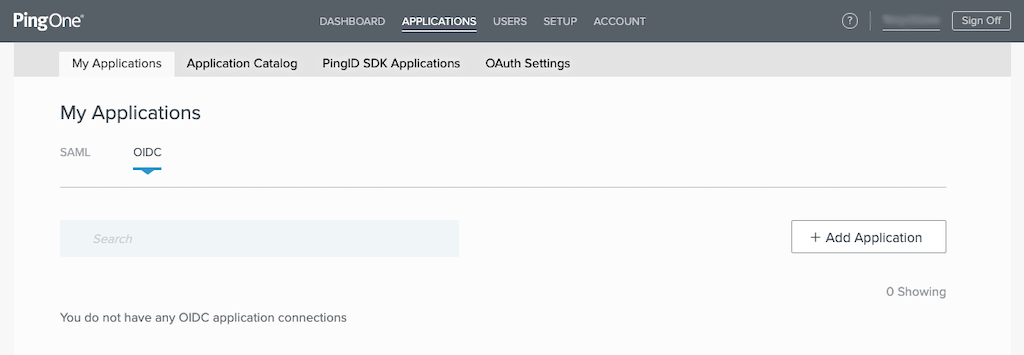
-
The Add OIDC Application window pops up. Click the ADVANCED CONFIGURATION box, and then the Next button.
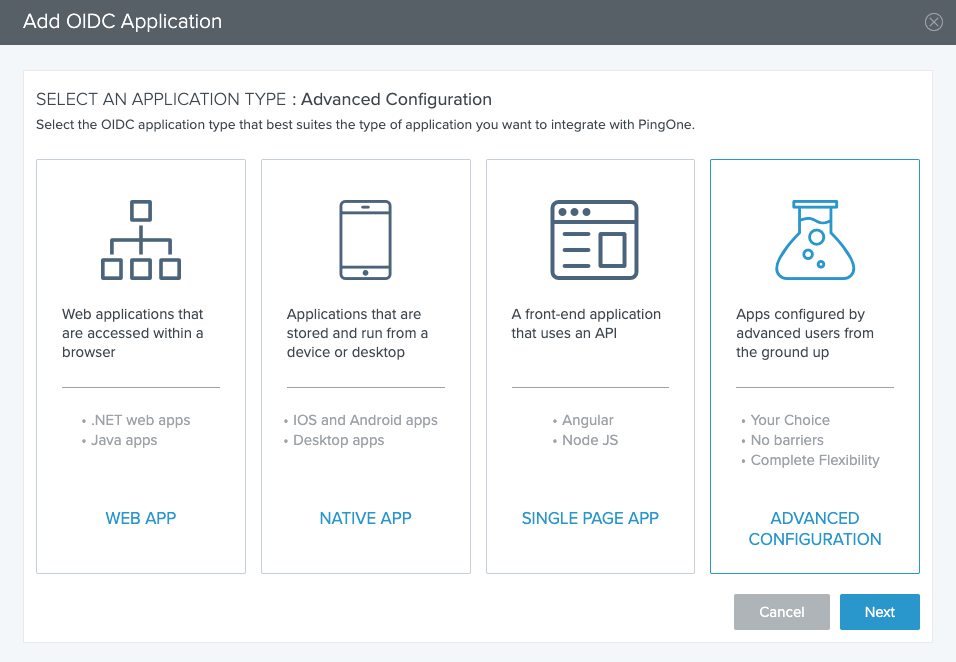
-
In section 1 (PROVIDE DETAILS ABOUT YOUR APPLICATION), type a name in the APPLICATION NAME field and a short description in the SHORT DESCRIPTION field. Here, we’re using nginx-plus-application and NGINX Plus. Choose a value from the CATEGORY drop‑down menu; here we’re using Information Technology. You can also add an icon if you wish. Click the Next button.

-
In section 2 (AUTHORIZATION SETTINGS), perform these steps:
- Under GRANTS, click both Authorization Code and Implicit.
- Under CREDENTIALS, click the + Add Secret button. PingOne creates a client secret and opens the CLIENT SECRETS field to display it, as shown in the screenshot. To see the actual value of the secret, click the eye icon.
- Click the Next button.

- Under GRANTS, click both Authorization Code and Implicit.
-
In section 3 (SSO FLOW AND AUTHENTICATION SETTINGS):
-
In the START SSO URL field, type the URL where users access your application. Here we’re using https://example.com.
-
In the REDIRECT URIS field, type the URI of the NGINX Plus instance including the port number, and ending in /_codexch. Here we’re using https://my-nginx-plus.example.com:443/_codexch (the full value is not visible in the screenshot).
Notes:
- For production, we strongly recommend that you use SSL/TLS (port 443).
- The port number is mandatory even when you’re using the default port for HTTP (80) or HTTPS (443).

-
-
In section 4 (DEFAULT USER PROFILE ATTRIBUTE CONTRACT), optionally add attributes to the required sub and idpid attributes, by clicking the + Add Attribute button. We’re not adding any in this example. When finished, click the Next button.
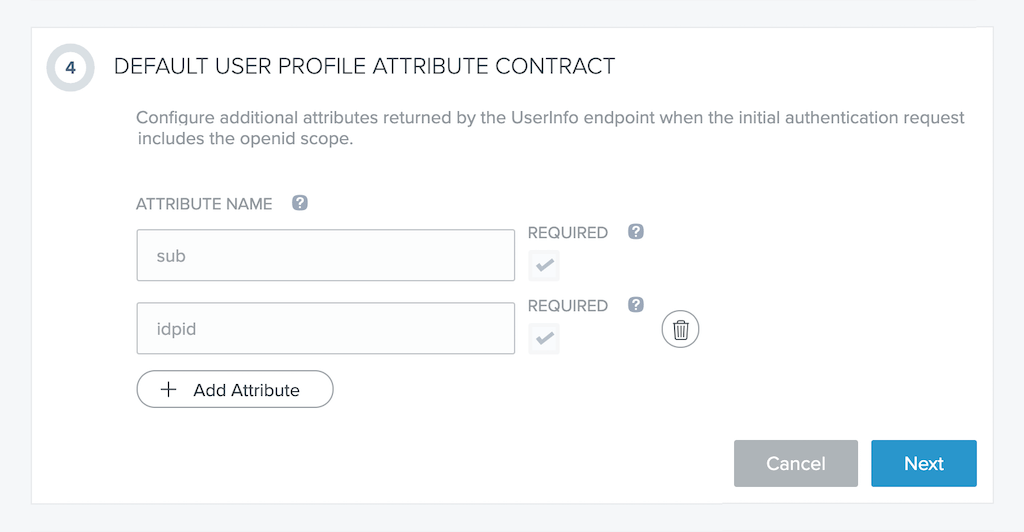
-
In section 5 (CONNECT SCOPES), click the circled plus-sign on the OpenID Profile (profile) and OpenID Profile Email (email) scopes in the LIST OF SCOPES column. They are moved to the CONNECTED SCOPES column, as shown in the screenshot. Click the Next button.

-
In section 6 (ATTRIBUTE MAPPING), map attributes from your identity repository to the claims available to the application. The one attribute you must map is sub, and here we have selected the value Email from the drop‑down menu (the screenshot is abridged for brevity).
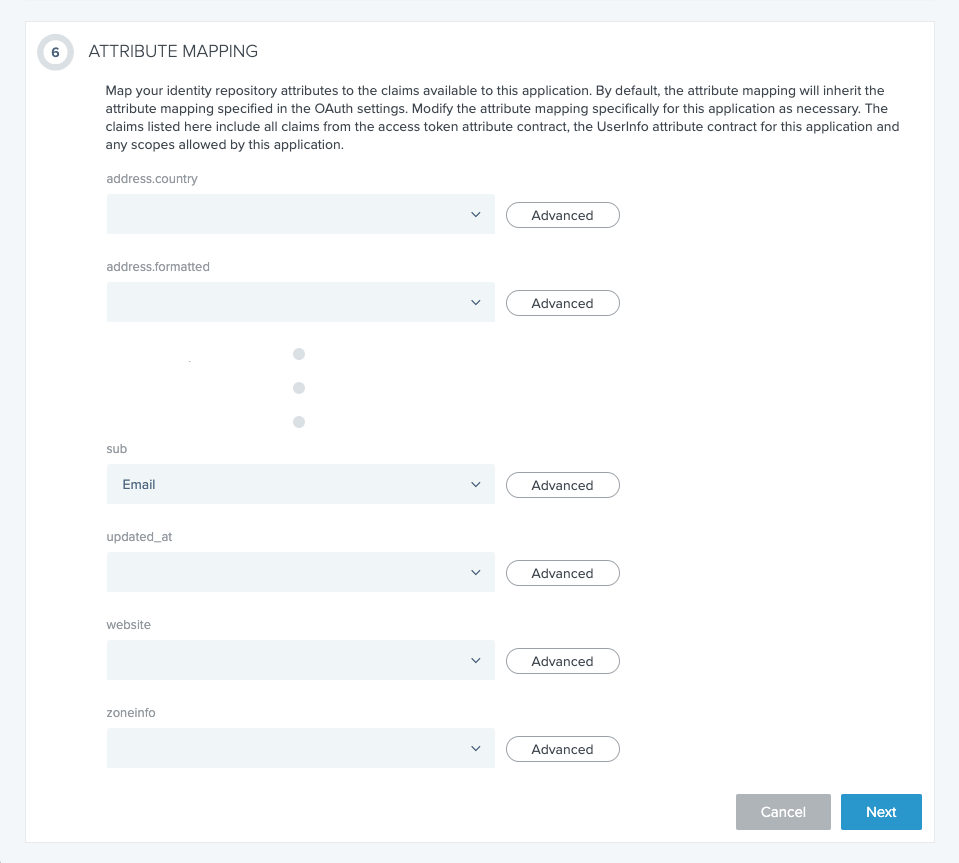
-
In section 7 (GROUP ACCESS), select the groups that will have access to the application, by clicking the circled plus-sign on the corresponding boxes in the AVAILABLE GROUPS column. The boxes move to the ADDED GROUPS column. As shown in the screenshot we have selected the two default groups, Domain Administrators@directory and Users@directory.
Click the Done button.
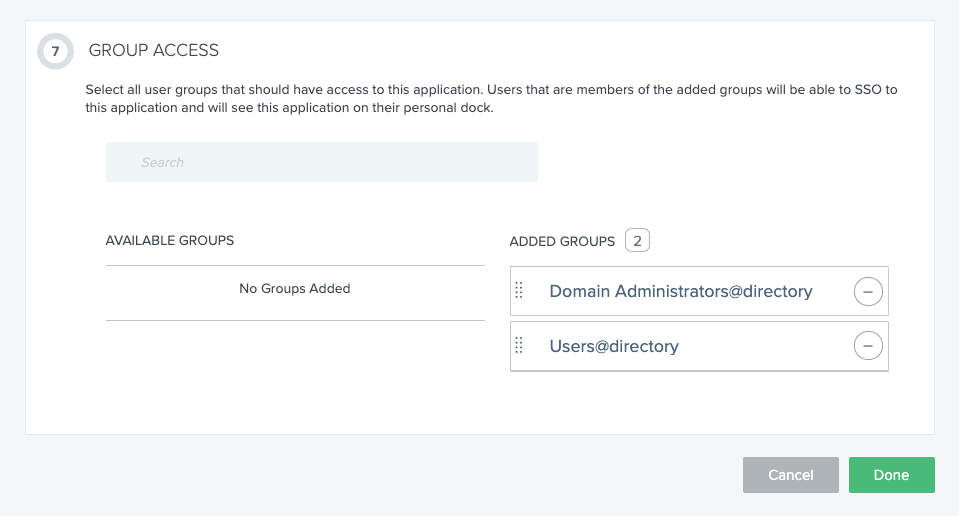
-
You are returned to the My Applications window, which now includes a row for nginx-plus-application. Click the toggle switch at the right end of the row to the “on” position, as shown in the screenshot. Then click the “expand” icon at the end of the row, to display the application’s details.
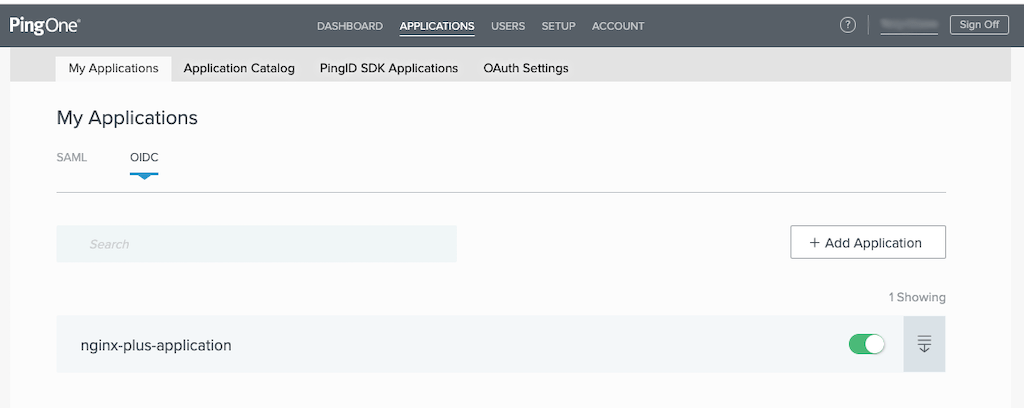
-
On the page that opens, make note of the values in the following fields on the Details tab. You will add them to the NGINX Plus configuration in Step 4 of Configuring NGINX Plus.
- CLIENT ID (in the screenshot, 28823604-83c5-4608-88da-c73fff9c607a)
- CLIENT SECRETS (in the screenshot, 7GMKILBofxb…); click on the eye icon to view the actual value
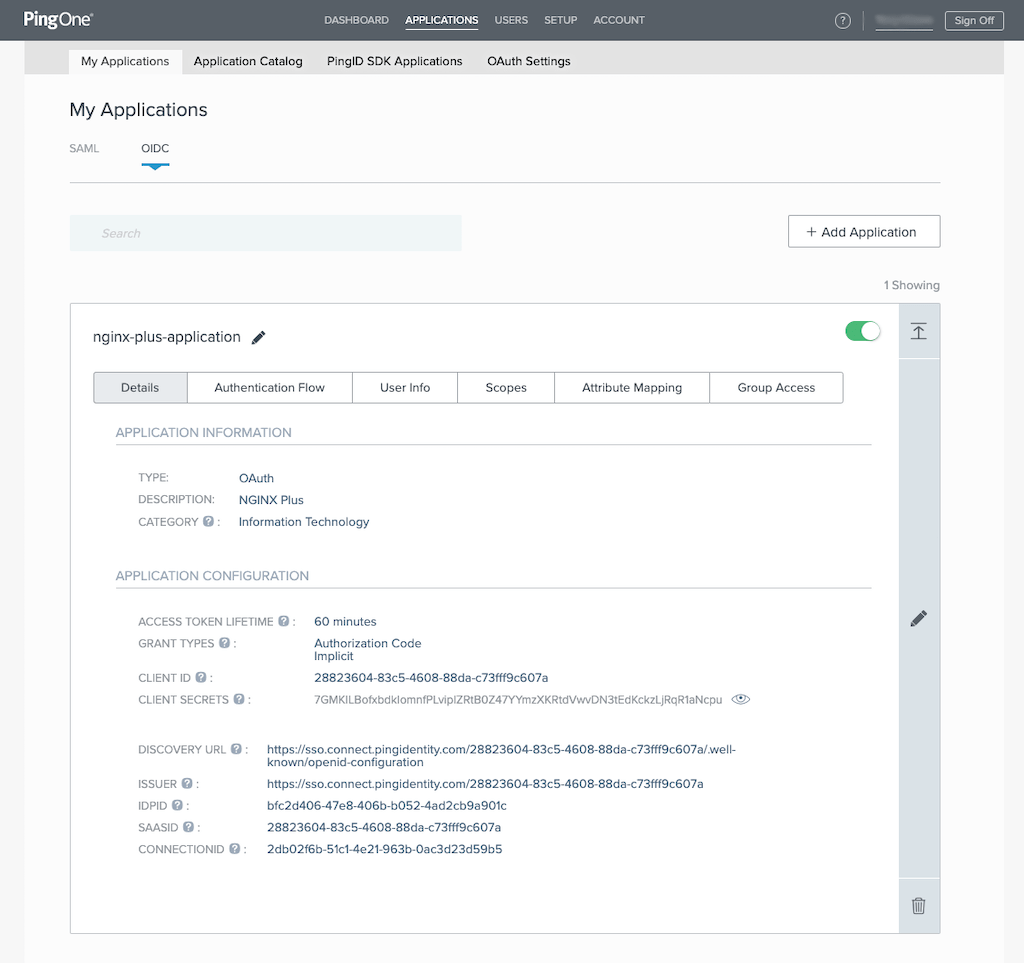
Configuring NGINX Plus
Configure NGINX Plus as the OpenID Connect relying party:
-
Create a clone of the nginx-openid-connect GitHub repository.
git clone https://github.com/nginxinc/nginx-openid-connect -
Copy these files from the clone to /etc/nginx/conf.d:
- frontend.conf
- openid_connect.js
- openid_connect.server_conf
-
Get the URLs for the authorization endpoint, token endpoint, and JSON Web Key (JWK) file from the Ping Identity configuration. Run the following
curlcommand in a terminal, piping the output to the indicatedpythoncommand to output the entire configuration in an easily readable format. We’ve abridged the output to show only the relevant fields.The
<Ping-Identity-Client-ID>variable is the value in the CLIENT ID field that you noted in Step 12 of Configuring PingFederate or PingOne for Enterprise.Note: This
curlcommand is appropriate for Ping One for Enterprise. For PingFederate, you might need to replacesso.connect.pingidentity.comwith the IP address of your local PingFederate server.$ curl sso.connect.pingidentity.com/<Ping-Identity-Client-ID>/.well-known/openid-configuration | python -m json.tool ... { "authorization_endpoint": "https://sso.connect.pingidentity.com/sso/as/authorization.oauth2", ... "jwks_uri": "https://sso.connect.pingidentity.com/sso/as/jwks", ... "token_endpoint": "https://sso.connect.pingidentity.com/sso/as/token.oauth2", ... } -
In your preferred text editor, open /etc/nginx/conf.d/frontend.conf. Change the second parameter of each of the following set directives to the specified value:
set $oidc_authz_endpoint– Value ofauthorization_endpointfrom Step 3 (in this guide,https://sso.connect.pingidentity.com/sso/as/authorization.oauth2)set $oidc_token_endpoint– Value oftoken_endpointfrom Step 3 (in this guide,https://sso.connect.pingidentity.com/sso/as/token.oauth2)set $oidc_client– Value in the CLIENT ID field in Step 12 of Configuring PingFederate or PingOne for Enterprise (in this guide,28823604-83c5-4608-88da-c73fff9c607a)set $oidc_client_secret– Value in the CLIENT SECRETS field in Step 12 of Configuring PingFederate or PingOne for Enterprise (in this guide,7GMKILBofxb...)set $oidc_hmac_key– A unique, long, and secure phrase
-
Configure the JWK file. The procedure depends on which version of NGINX Plus you are using.
-
In NGINX Plus R17 and later, NGINX Plus can read the JWK file directly from the URL reported as
jwks_uriin Step 3. Change /etc/nginx/conf.d/frontend.conf as follows:- Comment out (or remove) the auth_jwt_key_file directive.
- Uncomment the auth_jwt_key_request directive. (Its parameter,
/_jwks_uri, refers to the value of the$oidc_jwt_keyfilevariable, which you set in the next step.) - Change the second parameter of the
set $oidc_jwt_keyfiledirective to the value reported in thejwks_urifield in Step 3 (in this guide,https://sso.connect.pingidentity.com/sso/as/jwks).
-
In NGINX Plus R16 and earlier, the JWK file must be on the local disk. (You can also use this method with NGINX Plus R17 and later if you wish.)
- Copy the JSON contents from the JWK file named in the
jwks_urifield in Step 3 (in this guide,https://sso.connect.pingidentity.com/sso/as/jwks) to a local file (for example,/etc/nginx/my_ping_identity_jwk.json). - In /etc/nginx/conf.d/frontend.conf, change the second parameter of the
set $oidc_jwt_keyfiledirective to the local file path.
- Copy the JSON contents from the JWK file named in the
-
-
Confirm that the user named by the user directive in the NGINX Plus configuration (in /etc/nginx/nginx.conf by convention) has read permission on the JWK file.
Testing
In a browser, enter the address of your NGINX Plus instance and try to log in using the credentials of a user assigned to the application (see Step 10 of PingFederate or PingOne for Enterprise).
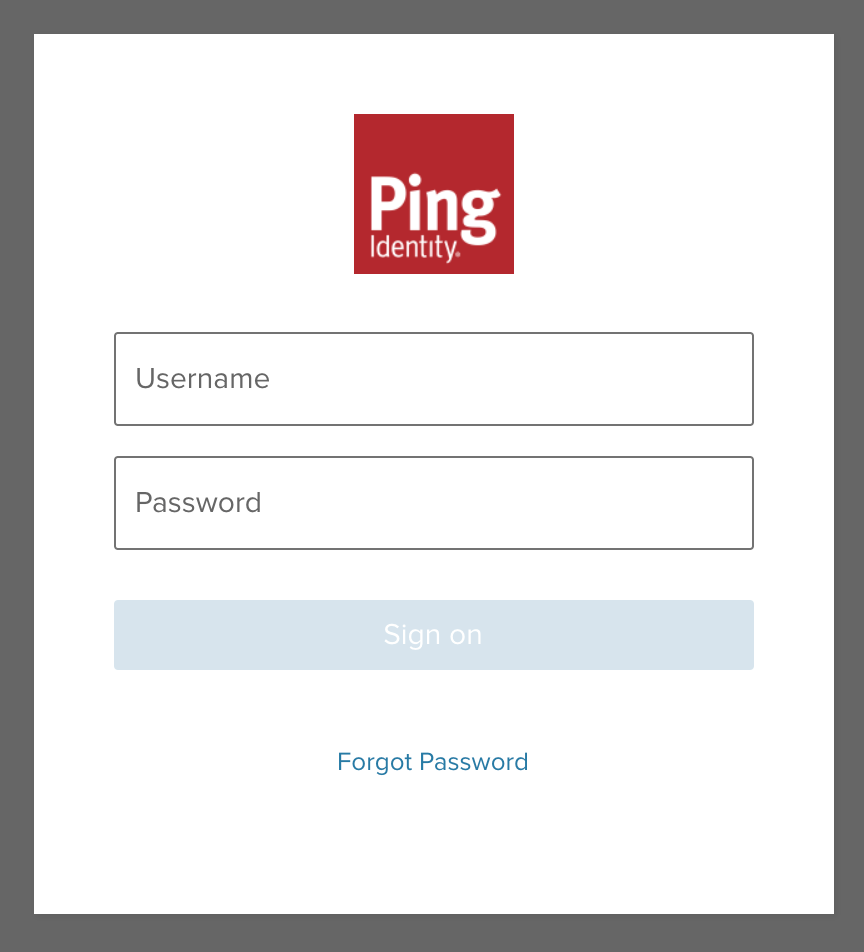
Troubleshooting
See the Troubleshooting section at the nginx-openid-connect repository on GitHub.
Revision History
- Version 2 (March 2020) – Updates to Configuring NGINX Plus section
- Version 1 (January 2020) – Initial version (NGINX Plus Release 20)